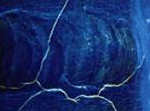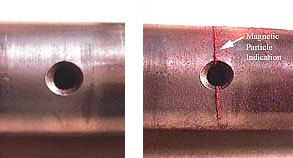|

Magnetic
Particle Inspection
Surface preparation: Less than 0.5mm of paint
Availability: Widely available
Safety implications: Fire hazard - Cable or prod electrodes
Coverage: Area - near surface
Materials: Ferromagnetic materials, e.g. carbon steels
Sensitivity: Minimum detectable flaw size: 1mm high x 5mm long
Theory
Magnetic particle inspection (MPI) is used for the detection of
surface and near-surface flaws in ferromagnetic materials. A
magnetic field is applied to the specimen, either locally or
overall, using a permanent magnet, electromagnet, flexible
cables or hand-held prods. If the material is sound, most of the
magnetic flux is concentrated below the material’s surface.
However, if a flaw is present, such that it interacts with the
magnetic field, the flux is distorted locally and ‘leaks’ from
the surface of the specimen in the region of the flaw. Fine
magnetic particles, applied to the surface of the specimen, are
attracted to the area of flux leakage, creating a visible
indication of the flaw. The materials commonly used for this
purpose are black iron particles and red or yellow iron oxides.
In some cases, the iron particles are coated with a fluorescent
material enabling them to be viewed under a UV lamp in darkened
conditions. applied to the surface of the specimen, are
attracted to the area of flux leakage, creating a visible
indication of the flaw. The materials commonly used for this
purpose are black iron particles and red or yellow iron oxides.
In some cases, the iron particles are coated with a fluorescent
material enabling them to be viewed under a UV lamp in darkened
conditions.
Magnetic particles are usually applied as a suspension in water
or paraffin. This enables the particles to flow over the surface
and to migrate to any flaws. On hot surfaces, or where
contamination is a concern, dry powders may be used as an
alternative to wet inks. On dark surfaces, a thin layer of white
paint is usually applied, to increase the contrast between the
background and the black magnetic particles. The most sensitive
technique, however, is to use fluorescent particles viewed under
black light.
MPI is particularly sensitive to surface-breaking or
near-surface cracks, even if the crack opening is very narrow.
However, if the crack runs parallel to the magnetic field, there
is little disturbance to the magnetic field and it is unlikely
that the crack will be detected.
 For this reason it is
recommended that the inspection surface is magnetised in two
directions at 90° to each other. Alternatively, techniques using
swinging or rotating magnetic fields can be used to ensure that
all orientations of crack are detectable. For this reason it is
recommended that the inspection surface is magnetised in two
directions at 90° to each other. Alternatively, techniques using
swinging or rotating magnetic fields can be used to ensure that
all orientations of crack are detectable.
The method of magnetisation depends on the geometry of the
component and whether or not all or only part of the specimen is
to be magnetised. Permanent magnets are attractive for
in-service inspection, in that they do not need a power supply.
However, they tend only to be used to examine relatively small
areas and have to be pulled from the test surface. Despite
needing their own power supply, electromagnets (yokes) find
widespread application. Their main attraction is that they are
easy to remove (once the current has been switched off) and that
the strength of the magnetic field can be varied. For example,
an AC electromagnet can be used to concentrate the field at the
surface where it is needed. Hand-held electrical prods are
useful in confined spaces. However, they suffer two major
disadvantages that can rule out their use altogether. Firstly,
arc strikes can occur at the prod contact points and these can
damage the specimen surface. Secondly, because the particles
must be applied when the current is on, the inspection becomes a
two-man operation.
In some cases, MPI can leave residual fields which subsequently
interfere with welding repairs. These can be removed by slowly
wiping the surface with an AC yoke.
What will it find?
MPI is used to detect surface-breaking and near-surface flaws in
ferromagnetic materials. It cannot, however, be used to detect
deeply embedded flaws, nor can it be used on non-ferromagnetic
materials, such as aluminium, copper or austenitic stainless
steel.
Application areas
MPI is often used to look for cracking at welded joints and in
areas identified as being susceptible to environmental cracking
(i.e. stress corrosion cracking or hydrogen induced cracking),
fatigue cracking or creep cracking. Wet fluorescent MPI finds
widespread use in looking for environmental damage in the inside
of vessels. Further information on each of these cracking
mechanisms and their significance in piping systems is given in
API 570.
Just as there is a general processing specification for
penetrants, there is one general processing specification for
magnetic particle inspection. The processing specification is
ASTM E-1444 “Standard Practice for Magnetic Particle
Examination”. (This specification replaced MIL-STD-1949.) There
are a number of AMS magnetic particle material specifications
listed in ASTM E-1444. These AMS specifications determine the
requirements for magnetic particle materials. These AMS
(Aerospace Material Specifications) can be purchased from the
Society of Automotive Engineers (SAE).
The list of AMS
specifications referenced in ASTM E-1444 is:
AMS 2641 “Magnetic Particle Inspection Vehicle” Replaced the
military specification DOD F-87935.
AMS 3040 “Magnetic Particle, Non-Fluorescent, Dry Method”
AMS 3041 “Magnetic Particle, Non-Fluorescent, Wet Method, Oil
Vehicle, Ready-to-Use”
AMS 3042 “Magnetic Particle, Non-Fluorescent, Wet Method, Dry
Powder”
AMS 3043 “Magnetic Particles, Non-Fluorescent, Wet Method, Oil
Vehicle, Aerosol Packaged”
AMS 3044 “Magnetic Particles, Fluorescent, Wet Method, Dry
Powder”
AMS 3045 “Magnetic Particles, Fluorescent, Wet Method, Oil
Vehicle, Ready-to-Use”
AMS 3046 “Magnetic Particles, Fluorescent, Wet Method, Oil
Vehicle, Aerosol Packaged”
AS 4792 “Water Conditioning Agents for Aqueous Magnetic Particle
Inspection”
AS 5282 “Tool Steel Ring Standard for Magnetic Particle
Inspection”
AS 5371 “Reference Standards Notched Shims for Magnetic Particle
Inspection”
In order to perform a magnetic particle inspection requiring an
oil bath and fluorescent particles, AMS 2641 “Magnetic Particle
Inspection Vehicle” and AMS 3044 “Magnetic Particles,
Fluorescent, Wet Method, Dry Powder" or AMS 3045 "Magnetic
Particles, Fluorescent, Wet Method, Oil Vehicle, Ready-to-Use”
should be specified to meet the certifying requirements for
magnetic particle inspection for this example.
A magnetic particle specification that is often referenced, is
ASTM E-709 “Guide for Magnetic particle Examination”. This
specification as its title suggests is a tutorial document to
provide additional information on magnetic particle examination.
ASTM E-709 provides additional information on the methods, and
quality control requirements for magnetic particle examination.
The general processing specifications for magnetic particle
inspection is ASTM E-1444 “Standard Practice for Magnetic
Particle Examination”. ASTM E-1444 does use supporting
specifications (ASTM E-709 and AMS Material Specifications to
name a few) for processing parts using the magnetic particle
method. ASTM E-709 is a guideline for magnetic particle
processing and should only be used as a supporting document to
ASTM E-1444.
Back to failure analysis tools
|



